Fig. 15.1
Weber classification of tibial reduction defects in seven types and five subgroups (a = with cartilaginous anlage, b = without cartilaginous anlage) according to the severity of the malformation. Black = bone, blue = cartilaginous anlage and red circle = tibial defect without cartilaginous anlage. The figure represents a higher maturation level of the lower leg instead of the situation immediately after birth because of the possibility to give more detailed illustrations
Table 15.1
Score system with classification of tibial reduction defect of the leg
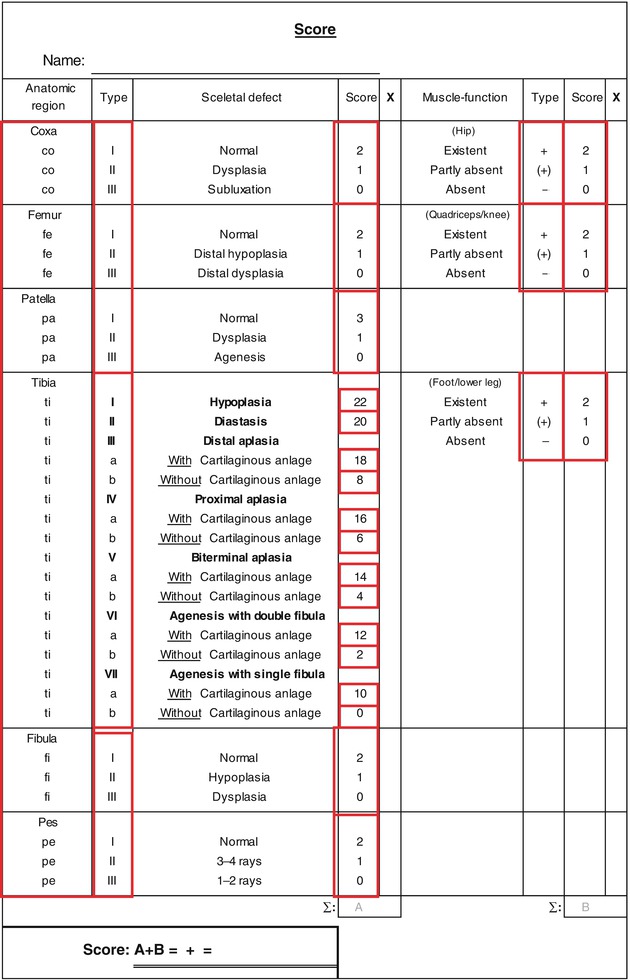
Table 15.2
Five different classes of tibial reduction defects of the leg according to the scores
Class | Score |
|---|---|
5 | 0–7 |
4 | 8–15 |
3 | 16–23 |
2 | 24–31 |
1 | 32–39 |
15.3 Examination, Imaging and Classification
Tibial hemimelia was previously classified according to bony structure and X-rays (Jones et al. 1978; Kalamchi and Dawe 1985). However, tibial hemimelia is a combined malformation of soft tissue, cartilage, bone and joints with leg and foot deformities, leg shortening, joint contractures and muscle and joint dysfunction. For this reason, I suggested a more comprehensive classification and score, where the tibial defects are detected more precisely, the pathological anatomical terms are used correctly, the whole leg and its function is included, a scientific comparison of the treatment outcome of different types and results from different authors is possible and, consequently, a recommendation for therapeutic options is given (Fig. 15.1, Tables 15.1 and 15.2; Weber 2008).
Examination of the patient should include the complete leg (coxa-femur-patella-tibia-fibula-pes) obviously with specific importance of the tibia and the muscle function at the different leg levels. The condition is characterized mainly by knee and ankle deformities. Usually, a global instability of the knee and/or ankle with contracture is present, depending which joint is affected by tibial aplasia or agenesia. The fibula is usually nearly normal developed but can be hypoplastic, dysplastic or bowed. The fibular head is located proximally and dorsally to the femoral condyle in proximal tibial aplasia’s (types I; IVa, b; Va, b; VIa, b and VIIa, b). The lateral malleolus is distally and dorsally positioned to the talus in distal tibial aplasias (types I; II; IIIa, b; Va, b; VIa, b; and VIIa, b). In biterminal tibial aplasias and tibial agenesia (types Va, b; VIa, b; and VIIa, b), the fibula shows an over length proximally and distally with dorsalization. In distal tibial aplasias the foot is positioned in varus (types: II; IIIa, b; Va, b; and VIIa, b), with or without equinus deformity. So more distinct the tibial aplasia, so more the deformity occurs. In tibial agenesia the deformities are the most. The foot can show adductus, supinatus and excavatus deformities as well as malformations in form of polydactyly, double foot, hypoplasia, aplasia, agenesia of digits and rays, synchondrosis and synostosis of the calcaneus and talus.
Precise diagnosis can be made using X-rays, CT scan, sonography and especially MRI. The intraoperative diagnostic of the anatomical structures, especially the course of tendons, is important for functional improvement. The patella (important for transformative knee arthroplasty) can be detected by ultrasound and MRI. The presence of a cartilaginous anlage, important for joint construction, can be detected by MRI; the use of gadolinium contrast in combination with MRI is useful. The muscle function and power as well as the amount of joint contractures should be detected at each joint level for planning of the surgical procedure (Tables 15.1 and 15.2).
Custom-made analysis is important and means to use modern techniques (ultrasound, MRI, etc.), precise examinations and the intraoperative view for analysing the biological resources, important for constructive surgery.
15.4 Procedures
This chapter is focused on constructive surgical techniques of the limb with motoric replacement, callus distraction, transformation and booster surgery rather than amputation and orthotic treatment methods. Each subgroup of the Weber classification (Weber 2008, Fig. 15.1) has its own treatment strategies which are explained below. The principle of the surgical procedure is to increase the function and the length of the affected leg and foot:
Motoric replacement techniques are used to align tendon structures to their proper insertions.
Soft tissue distraction as preparation of fibula pro tibia transformation and foot centralization.
Callus distraction is performed to increase the length of the shortened bones and corrects deformities.
Transformation surgery gives anatomical structures a new function.
Booster surgery improves the growth of the cartilaginous anlage of the tibia and creates joints.
The use of ring fixators (Mini-Ilizarov, Maxi-Ilizarov and Taylor Spatial Frame) is preferred because they give the best stability and correction options. I use the different fixator types according to their advantages and combine them together to enhance their advantages.
The postoperative functional results should be better than before surgery and better as a nonoperated leg supported by an orthoprosthesis or prosthesis only.
The treatment can be divided generally into three stages: (1) a preoperative planning and preparation stage; (2) surgery and correction period; (3) removal of the fixator, preserving correction and restore function. All three stages are accompanied with intensive physiotherapy and ergotherapy to prevent or to treat contractures. A versatile and individual technical support by orthesis and orthoprosthesis is essentially at all stages of treatment especially at stage one and three. Especially after removal of the fixator, the callus should be protected from fracturing by a brace, by a cast or even better by an orthotic device. By wearing a custom-made brace, the risk of callus fracture during physiotherapy can be reduced.
The type of treatment should not focus only on the operative possibilities and should respect the wishes of the patients and/or parents/guardians.
15.4.1 Type I: Hypoplasia of the Tibia (Fig. 15.1)
This type is characterized by a complete osseous anlage of the tibia with distal and proximal joint. The tibia is shorter in contrast to the increased length of fibula. The treatment is focused on lengthening of tibia to its correct length in relation to fibula. It can be achieved with two ways: First, application of frame only to tibia and lengthening of tibia by callus distraction. This method applies great tension on soft tissues and can lead to joint subluxations, rarely at the ankle but mostly at the knee depending on the amount of lengthening. Therefore, lateral collateral ligament (ligamentum capitis fibulae) and other soft tissue releases (e.g. Achilles tendon) are necessary before lengthening. Second, this technique includes a montage of the frame over knee and ankle joint to preserve joint function whilst lengthening. Joint subluxation is avoided with this method, but joint stiffness becomes a problem after long-term immobilization. To prevent joint contracture, isometric mechanical hinges can be placed at the axes of the joints with slight acute distraction on the joint capsule of up to 5 mm and are used to mobilize the joints 6 weeks after the lengthening is stopped.
15.4.2 Type II: Distal Diastasis of the Tibia (Figs. 15.2, 15.3, 15.4, 15.5, and 15.6)

Fig. 15.2
Leg no. 7. (a) Schematic drawing of tibial reduction defect Weber type II with tibiofibular diastasis and luxated foot. (b) Preoperative X-ray of treated leg with Weber type II. (c) Related score of leg (score: 37, class: I)
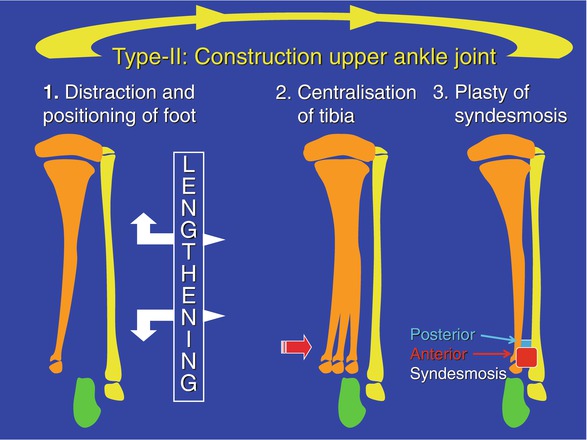
Fig. 15.3
Leg no. 7. Schematic drawing of surgical procedure for treatment of tibial reduction defect Weber type II of left leg. (1) Soft tissue distraction with correct positioning of the luxated foot. (2) Acute centralization of tibia to talus. (3) Protection of the centralized tibia from recurrence of diastasis by plasty of syndesmosis with perichondrial-periosteal flaps

Fig. 15.4
Leg no. 7. Intraoperative pictures of ankle joint construction and procedure of syndesmosis plasty. (a) After preparation of joint capsule, construction of correct alignments of intra-articular tendons and holding them aside by vessel loops. The posterior perichondrial-periosteal flap is prepared from the dorsal part of the tibia and sutures inserted (arrows). (b) The tibia is positioned acutely with forceps and secured by an intramedullary K-wire through talus and tibia. The anterior perichondrial-periosteal flap is sutured to the anterior surface (arrows) of fibula after suturing of the posterior flap to the posterior surface of fibula
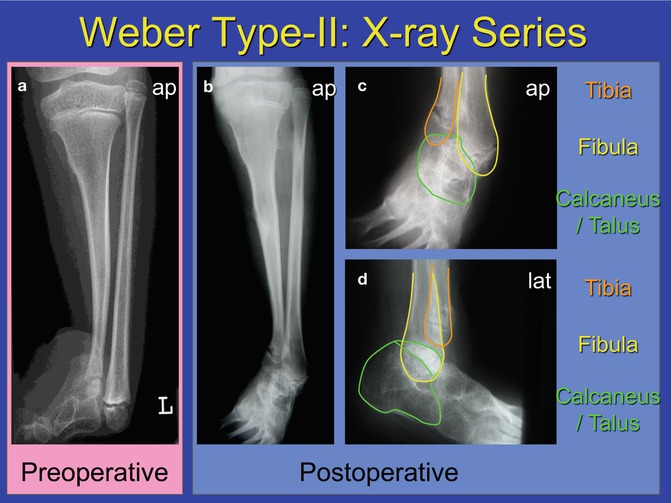
Fig. 15.5
Leg no. 7. X-ray series: (a) preoperative; (b–d) postoperative, after ankle construction with positioning of foot and distal tibia, alignment of extensor tendons and plasty of the syndesmosis ventrally and dorsally by perichondrial-periosteal flaps. (a) Diastasis of the left tibia and fibula distally with luxated foot according to Weber type II. Hyperplasia of distal fibula occurred due to the fact that the patient was walking on the tip of fibula. (b) Lower leg and foot ap. (c) Ankle ap. (d) Ankle lat: different coloured lines marking the contours of the corrected bones
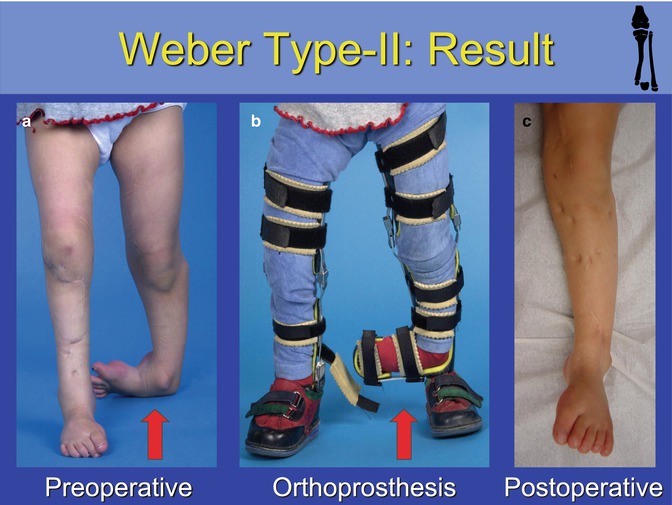
Fig. 15.6
Leg no. 7. Clinical pictures of the 6-year-old girl with diastasis of the left tibia and fibula distally with luxated foot according to Weber type II before (a, b) and after surgery (c). (a) The girl is walking with a luxated foot on the tip of the fibula. (b) The preoperative orthoprosthesis could hardly enable the patient for walking. (c) After surgery the left leg was supported for further growth guidance by lower leg orthotics with Tamarack joints at ankle level. Later, the lower leg orthotics could be removed and normal shoes could be worn
Insufficiency of the syndesmosis and transverse separation of tibia and fibula leads to subluxation/luxation of the ankle joint with proximalization of foot and talus between tibia and fibula (Figs. 15.2 and 15.6). For treatment, the foot is distracted with a foot integrating fixator to the level that the distal tibia can acutely be positioned over the talus without stress. Then, diastasis is corrected acutely with reconstruction of syndesmosis using anterior and posterior periosteal flaps, peroneal tendon plasty or allografts (Figs. 15.3 and 15.4). The tendons, which often are disoriented and can be aligned through the ankle joint, should be prepared and aligned properly. An axially placed wire secures ankle joint and tibia, whilst an olive wire preserves syndesmosis reconstruction during healing. After 6 weeks the wires can be removed and the upper ankle joint can be mobilized by the adjusted isometric mechanical hinges. Due to luxation of the foot with weight bearing of fibular tip and/or no weight load of the tibia, hyperplasia of distal fibular end and/or increase of hypoplasia of tibia occurs. So much the luxation of foot lasts, so more time it takes to recover proper structures after reposition of foot (Fig. 15.5).
15.4.3 Type IIIa: Distal Aplasia of the Tibia with Cartilaginous Anlage (Figs. 15.7, 15.8, and 15.9)
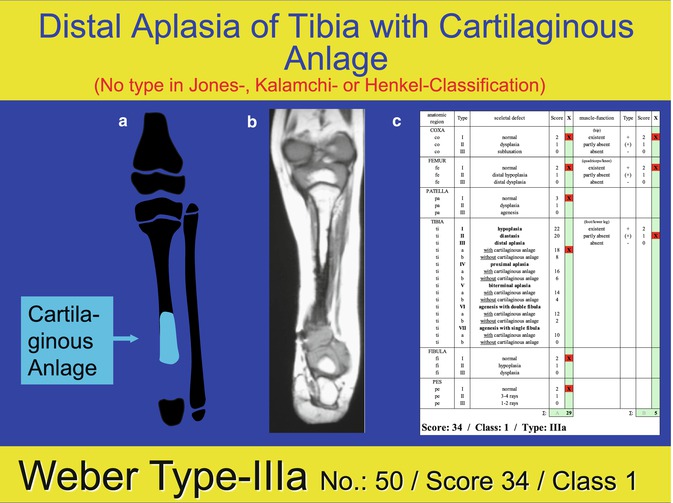
Fig. 15.7
Leg no. 50. (a) Schematic drawing of tibial reduction defect Weber type IIIa with tibial aplasia distally and with cartilaginous anlage of left leg. (b) Preoperative MRI of lower leg showing the cartilaginous anlage. (c) Related score of leg (score: 34, class: I). No type in the classifications of Jones et al. (1978), Henkel et al. (1978) and Kalamchi and Dawe (1985) available
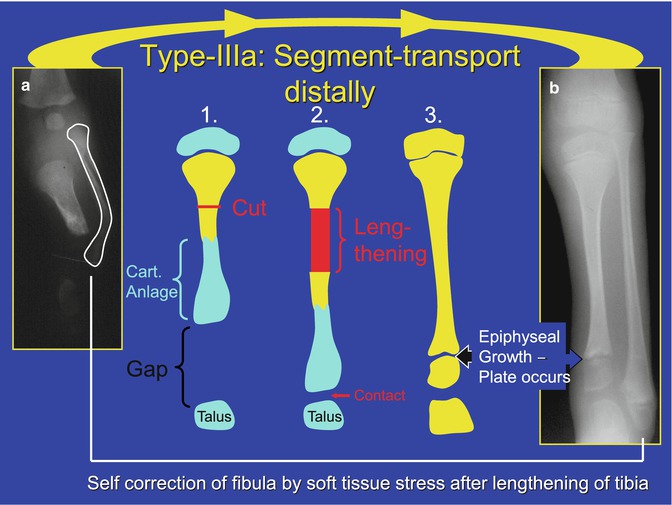
Fig. 15.8
Leg no. 50. Schematic drawing of operational procedure for treatment of tibial reduction defect Weber type IIIa. (1) Osteotomy at the bony part of the proximal tibia. (2) Callus distraction of the tibia to bring the cartilaginous anlage in contact with the talus. (3) Status after maturation of callus and development of tibial growth plate distally at area of former cartilaginous anlage. (a) Preoperative X-ray of left lower leg of a 3-year-old boy with severe bowing of fibula due to over length in relation to tibia. (b) X-ray of left lower leg with complete maturation of the cartilaginous anlage due to growth stimulating effect of callus distraction and weight bearing with epiphyseal growth plate of distal tibia and good ankle joint configuration 4 years after surgery
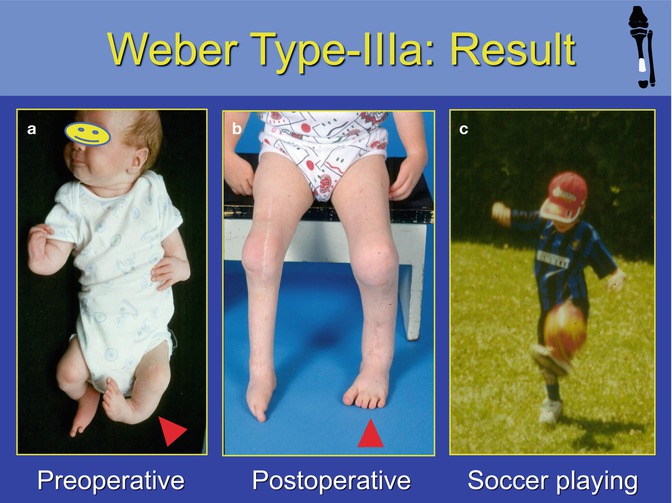
Fig. 15.9
Leg no. 50. Clinical results including orthoprosthesis care. (a) Preoperative, all four extremities show malformations: bilateral radial club hand and bilateral tibial reduction deficiency (see Spranger et al. 1996). (b) The left leg after surgery can take full weight load and shows nearly normal ROM of upper ankle joint. According to the procedure of the right leg see Figs. 15.29, 15.30, 15.31, 15.32, 15.33, and 15.34. (c) The boy is able to play soccer, skiing and skateboarding protected with orthotic devices
The proximal part of the tibia is ossified with normal knee joint, whilst the distal tibia is not ossified and a cartilaginous anlage is present without having contact with the talus (Figs. 15.7 and 15.9). The principle of the treatment is to bring the distal cartilaginous anlage in contact with the talus to form an ankle joint (Fig. 15.8). A proximal tibia osteotomy at the osseous part is performed and distracted until contact. Magnetic resonance imaging (MRI) can be used to measure required lengthening, and contact can be demonstrated with contrast arthrography. The new ankle joint is mobilized with isometric hinges mounted on the foot integrated fixator until callus maturation and removal of fixator (Fig. 15.9).
15.4.4 Type IIIb: Distal Aplasia of the Tibia without Cartilaginous Anlage (Figs. 15.10, 15.11, 15.12, 15.13, 15.14, 15.15, and 15.16)
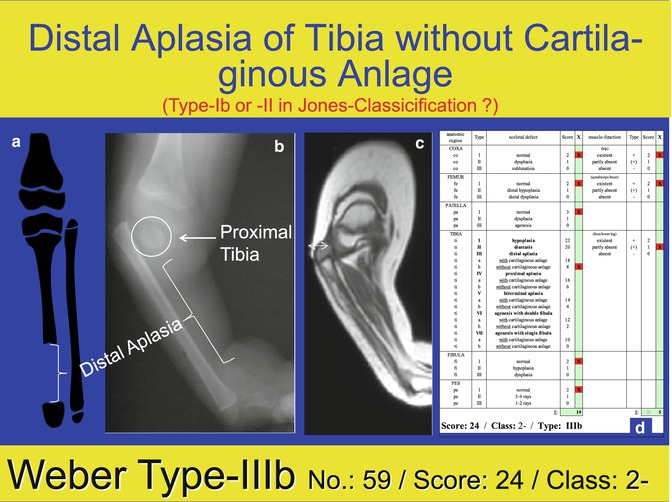
Fig. 15.10
Leg no. 59. (a) Schematic drawing of tibial reduction defect Weber type IIIb with tibial aplasia distally without cartilaginous anlage. (b) Preoperative X-ray of right lower leg showing the bony anlage of proximal tibia (white circle). (c) MRI of right leg demonstrates the aplasia of distal tibia without cartilaginous anlage. (d) Related score of leg (score: 24, class: 2−). Unclear which type it could be in the Jones classification (Jones et al. 1978)
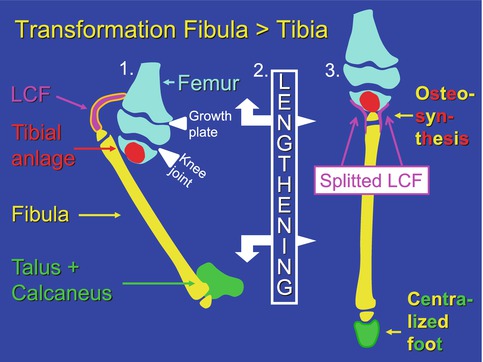
Fig. 15.11
Leg no. 59. Schematic drawing of operational procedure for treatment of tibial reduction defect Weber type IIIb. (1) Schematic situs. (2) Soft tissue lengthening after detachment of ligamentum capitis fibulae from femoral insertion and lengthening of Achilles tendon. (3) Centralization of fibular head and osteochondrosynthesis of fibular head into proximal tibia. The LCF is splitted longitudinally and attached medially and laterally to the tibia. Centralization of foot is performed (see Figs. 15.14, 15.15, and 15.16)
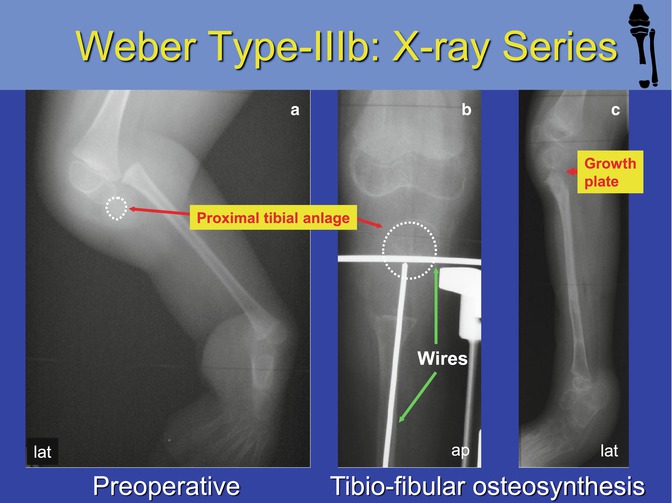
Fig. 15.12
Leg no. 59. X-ray series of a 6-year-old girl with tibial reduction deficiency Weber type IIIb. (a) Preoperative situation. (b) Transfixation of tibial anlage and fibular head by an axial fibular and a transverse wire through the bony proximal tibial anlage. (c) Result after surgery. Note the open growth plate of the former fibular head after the solid fusion between fibular head and proximal tibial anlage
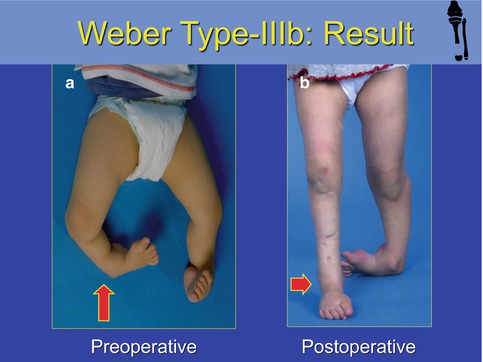
Fig. 15.13
Leg no. 59. (a) The right leg before surgery showing the malformation of the lower leg with complete instability at knee level and luxated clubfoot. (b) The result after surgery shows correct axis of lower leg with slight reduction of knee flexion but full extension, normal ROM of upper ankle joint and corrected club foot
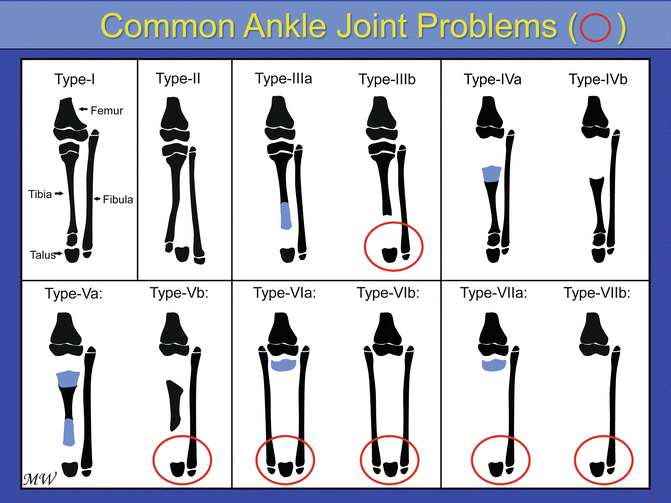
Fig. 15.14
Weber classification of tibial reduction deficiencies. The red circles are marking the common unstable ankle joint problems in different types (IIIb, Vb and VI–VII) which can be treated in two different ways (see Sect. 15.4.4): stabilization either by bilaterally malleolus plasty with transformation of iliac crest transplant into malleolus (Weber 2002) or bilaterally periosteal flaps transforming into collateral ligaments (see Figs. 15.16 and 15.17)
Stay updated, free articles. Join our Telegram channel

Full access? Get Clinical Tree








